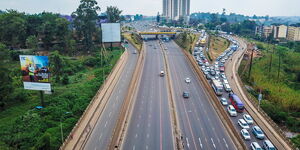Transport Permanent Secretary, Mohamed Daghar on March 4.
Kenya Ports Authority (KPA) has disclosed a notable downturn in cargo traffic passing through the Standard Gauge Railway (SGR) and the Nairobi Inland Container Depot, with figures dropping persistently since 2019, as per the recent Kenya Ports Authority Annual Review and Bulletin of Statistics released on Monday.
According to the report, the total twenty-foot equivalent units (TEUs) utilising the SGR in 2019 amounted to 418,830 containers. This is despite a 6 per cent surge in cargo using the Port of Mombasa.
However, this figure saw a significant decline, plummeting to 338,394 containers by 2023.
Additionally, the number of trains ferrying cargo from KPA also witnessed a reduction, decreasing from 4,255 trains in 2019 to 3,512 trains in the past year.
Despite the downward trend, the railway system, which commenced freight operations in December 2017, experienced its peak performance in 2021, when it facilitated the movement of 434,069 containers, the report highlighted.
Similarly, the Nairobi Inland Container Depot experienced a parallel decline, with only 332,100 containers passing through the site compared to 403,665 containers in 2022.
The Naivasha Inland Container Depot, situated off the Kaplong-Narok-Maai Mahiu Road on the Kenya Pipeline access road, faced a drop in figures from 10,688 in 2020 to 6,294 in 2023.
Notwithstanding the reduction in container numbers, data from the Kenya Railways Corporation (KRC) reveals a sharp rise in freight haulage via SGR, increasing to 6.29 million tonnes from 5.66 million tonnes in the year ending June 2022.
This surge in demand for cargo transportation through the line was been attributed to its reliability, quality of service, and convenience.
"The demand for the service grew over the period arising from its reliability, quality of service, and convenience," a statement from the firm earlier this year remarked.
In terms of transit markets, Uganda, South Sudan, and the Democratic Republic of Congo (DRC) emerged as the biggest, accounting for 62.3 per cent, 52 per cent, and 57 per cent of the total volumes, respectively, in 2023.
The report further indicated that China remains Kenya’s principal trading partner in both imports and exports. India, the United Arab Emirates, Egypt, and Saudi Arabia feature in the top five import partners, while India, Vietnam, the United Arab Emirates, and Pakistan comprise the top five export partners for Kenya.
Among the key exports in 2023 were tea, coffee, and titanium, while oil products, wheat, and steel dominated the import charts.
The decline in cargo traffic comes amidst Kenya's significant debt to China amounting to equivalent to Ksh814 billion at current exchange rates borrowed in 2014 and 2015 to fund the construction of the Mombasa-Naivasha SGR line.
Repayments for the loans, which were on a mix of concessional and commercial terms, commenced in January 2020 after a five-year grace period.












